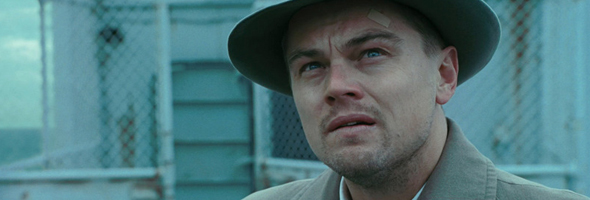Never say Martin Scorsese wasn’t willing to try something new. Much like Spielberg or Coppola, the auteur jumps at the opportunity to tackle subject matter not immediate to the modus operandi that developed his reputation: tough-talking New York City Italians with a penchant for violence.
So it is with Shutter Island, the closest thing we’ll get to a Hitchcock film these days: a fresh experiment in fear and psychoanalysis. And not an Italian in sight. But violence personified.
Based on the novel of the same name by Dennis Lehane (Mystic River, Gone, Baby, Gone) and from an adapted screenplay by Laeta Kalogridis, Shutter Island tells the story of Teddy Daniels (Leonardo DiCaprio) and his new partner Chuck Aule (Mark Ruffalo), two U.S. Marshals on assignment at Shutter Island (off the coast of Massachusetts) to investigate to disappearance of a patient from the mental institution Ashecliffe.
As the two arrive on the island the score rages louder and louder, each gate closing behind them as a new one opens in front. Finally they’re inside.
And that’s where this film lives: inside. Inside Daniels’ tortured mind, fighting violent, blood-splattered WWII memories and those of his dead wife Dolores, who burned with their apartment building some time ago. The doctors who run the institutions, Cawley (Ben Kingsley) and Naehring (Max Von Sydow), diagnose the marshal upon his arrival, picking his brain as much he picks theirs about their missing patient, who’s nowhere to be seen.
This is a Hitchcock horror film at the most menacing. Recall the way Vertigo doesn’t pull down the curtain of obsession, but rather peels it off, layer by layer until there’s nothing left to grab hold of. Or Psycho. Or Spellbound. Daniels’ dreams make no sense at first: rambling avant-garde fevers with blood running and cigarettes burning cold, full of cut-up faces and dead children reminiscent of Kubrick. And then he wakes up to a reality that plays like another nightmare.
Scorsese is all atmosphere here, calculating the moves of his camera like a pro who never lost the ambition (or flawed curiosity) of a film student. Some shots work, some don’t. He employs cheap, distracting green screens as a homage to the suspense master and over-the-top dialogue on the nature of men and violence. There’s a clear agenda going on throughout this picture – Scorcese wants to create a nightmare, full of guilt and regret and blood lust; one that the audience cannot escape.
In one of the film’s more brilliant touches, Daniels has a conversation with a woman (Patricia Clarkson) in a cave somewhere on the island. It’s a simple two-shot back and forth, with one obstruction: the flames from the fire between the two subjects flicker in front of their faces throughout. It’s a goddamned flicker film in the middle of a Hollywood motion picture, both distorting and enriching the world for the viewer who, at this point in the film, may be losing his mind.
Lehane’s book is one of the more dense page-turners to get published in recent years and hard choices most certainly had to be made in the adaptation. Some important things miss the cut. The Dolores character (played by Michelle Williams) is never developed enough, cheapening her torn relationship with Daniels. The actual mystery of the missing patient is side-stepped a bit, as is the “rule of four” mechanism which the book employs much more into the plot. This results in a rather didactic, Psycho-like misstep of an climactic explanation.
But the passion is there, as it always is with Scorsese. And his players transcend the effort with strong efforts of their own. DiCaprio is at the top of his game here. He carries the film with the tired eyes of a hunter, weary of catching prey but too hungry to stop. The young actor has never looked older, and the gray looks good on him. Ruffalo doesn’t have enough to do, but he does well with it anyway, in one scene in particular in which he and Daniels discuss the goings-on of the institution while a hurricane of a storm nearly breaks the walls around them.
The continuity editing could certainly be better, but, like several other Scorsese pictures, it reads like perhaps Thelma Schoonmaker was simply not given enough coverage to hide the discrepancies. At best these editing mistakes give this flawed film even more criticisms to elaborate on, at worst, they look lazy.
And laziness does not fit well into this manic, frantic film. But perhaps the discontinuity does?
It’s hard not to throw Scorsese a few bones, given his accomplishments, and a significant number of credible critics have gone out of their way to avoid just that.
But a feverish, affecting film is a feverish, affecting film and the abundant flaws will be food for thought for years to come.
8 out of 10
What did you think of Shutter Island?


